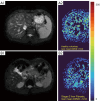Potential diverse applications of diffusion-derived vessel density (DDVD) pixel-by-pixel mapping
- PMID: 38545048
- PMCID: PMC10963825
- DOI: 10.21037/qims-24-164
Potential diverse applications of diffusion-derived vessel density (DDVD) pixel-by-pixel mapping
Keywords: Diffusion-weighted imaging (DW imaging); diffusion-derived vessel density (DDVD); fibrosis; oncology; placenta accreta.
Conflict of interest statement
Conflicts of Interest: All authors have completed the ICMJE uniform disclosure form (available at https://qims.amegroups.com/article/view/10.21037/qims-24-164/coif). Y.X.J.W. serves as the Editor-in-Chief of Quantitative Imaging in Medicine and Surgery. Y.X.J.W. is the founder of Yingran Medicals Ltd., which develops medical image-based diagnostics software. The other authors have no conflicts of interest to declare.
Figures












References
-
- Hu GW, Zheng CJ, Zhong WX, Zhuang DP, Xiao BH, Wáng YXJ. Usefulness of diffusion derived vessel density computed from a simplified IVIM imaging protocol: An experimental study with rat biliary duct blockage induced liver fibrosis. Magn Reson Imaging 2021;84:115-23. 10.1016/j.mri.2021.09.013 - DOI - PubMed
Publication types
LinkOut - more resources
Full Text Sources
